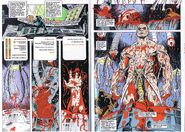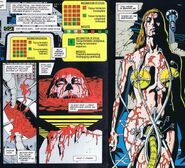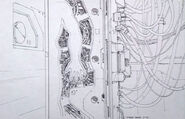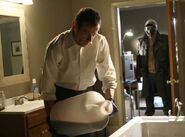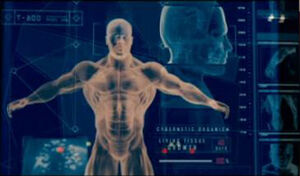
The blueprint of the Series 800 Terminator with living tissues.
Skynet developed the ability to grow living tissue over the endoskeletons of Terminators to make them the Infiltrator, allowing the machines to infiltrate the Resistance, as well as generate the bio-electric field necessary to send Terminator units back in time.
The Series 800 Terminator is the first truly successful Infiltrator unit, consisting of living tissue over a metal endoskeleton.
Process of growing living tissue
Synthetic blood plasma culture tank
The process of growing living tissue on Terminators is made by surrounding the endoskeleton with a special liquid of synthetic blood plasma, which is done in industrial facilities of Skynet. The Terminator: Secondary Objectives #1
Molding
The Terminator endoskeletons are placed inside a mold, which are presumably filled with a liquid possible similar to the one mentioned above, but directly controlled in order to produce finished and natural infiltration sheaths. Terminator 2: Judgment Day teaser trailer
Synthetic blood plasma bath
In some cases, Terminators can grow living tissue by lowering themselves into a synthetic blood plasma bath. This field-expedient method of damaged tissue replacement requires the coercion and compliance of contemporary humans (theoretical hematologists, plastic surgeons), both to produce the synthetic bath, and to shape and refine the finished flesh product, as it is initially quite gruesome. The raw flesh generation and the corrective surgical procedures combined take several days to complete. "The Turk"
Serena Burn's method
A more refined process was utilized by the I-950 Infiltrator in the creation of fully formed Series 800 Terminators in the present utilizing a combination of contemporary materials and chemical extracts of her own enhanced blood. Fully formed infiltration sheaths with the Model 101 template were part of the two-month long crafting process in the Secret Terminator Lab. T2: Infiltrator After adding tissue accellerants and remembering to alter key factors in the tissue matrix, T2: Rising Storm a wider variety of appearances was available in a shorter time.[1]
Terminator Salvation timeline
Known Terminator Series with living tissues
Model
- Main article: Model
The model of a Terminator, such as the Cyberdyne Systems Model 101, refers to the template of the living tissue sheath which surrounds the endoskeleton.
Infiltration
- See also: Infiltrator
Originally, Terminators were purely robotic and weren't covered with living tissue. Starting with the Series 600 Terminator, Skynet tried to cover the endoskeleton with rubber, which looked fake and was easy to be spotted. Skynet discovered a method that allowed them to grow living tissue over the endoskeleton, making the new Terminators almost impossible to spot.
The human based cyborg Dudley, formerly an ER trauma surgeon and combat medic in the Resistance, was made into a mobile field unit for the maintenance of Skynet's newly perfected Series 800 Infiltrator. In their initial fielding, it still took over a year to cultivate a viable human tissue sheath for the infiltration units, and Skynet needed something small and familiar with human tissue, able to maintain the perishable and hard to replace tissue sheaths. Tissue repair (again) became his primary function.
Time Travel
In order for this time travel to occur, the subject must be a living organism (or must be surrounded by living tissue) in order to generate the bioelectric field needed for the Time Displacement Equipment to operate. The subject must also be injected with amphetamines, and smeared with a thick, bluish, sour smelling super conducting jelly so that the time-field will follow its outline. [citation needed]
The Series 1000 Terminator is wrapped in a cocoon made of living tissue for time travel,[2][3] while it is unknown if a Series X Terminator travel with the same method via Time Displacement Equipment or not.
Specification
Mankind unraveled the human genome and identified the genes which controlled cell life-span and degradation. Using this information, stored within its vast databases, Skynet was able to eliminate these unwanted genes from cells prior to industrially growing biological components for the Series 800 Terminator.
This means that the skin and muscles of the Series 800 Terminators, unlike the human equivalents, do not wear down, degrade or necrotize over relatively short periods of time.[citation needed] It also means that the T-800's biological components will not rot over long periods of time, and do not require a flow of nutrients or anti-bodies. However, if a T-800 is left on the battlefield for too great a period, its biological components will begin to rot, and its cover will be blown. Moreover, in favorable weather conditions, the living tissue will decay and show signs of aging comparable to a normal human.[4]
Though it does not need nutrient or blood flow, the T-800 has a circulatory system which is controlled by a tiny pneumatic pump which maintains a constant pressure. This allows the T-800 to bleed convincingly when wounded. However, the living tissue of the T-800's is still prone to necrotizing after a period. Therefore, when not in active service, flesh covered T-800's are stored in special racks in a cryogenic vault to preserve the flesh from deteriorating.
In the film The Terminator, after being shot multiple times during the shootout in the police precinct, T-800's skin has a noticeably pale color and flies are sitting on its face. At this point the janitor of the building, which T-800 was using as a safehouse, commented on the smell of decay coming from T-800's room: "Hey, buddy, got a dead cat in there, or what?" Thus the living tissue of Series 800 apparently may "die" or at least undergo extensive necrosis. Nevertheless, in Terminator 2: Judgment Day, when the T-800 was having bullets removed from his back, it explained that the wounds would heal over time. So it seems the living tissue sheaths of the Series 800 are still capable of limited regeneration thus aiding in future infiltration. Judging from the first film, however, the tissue may be damaged so much that the necrosis will spread beyond regeneration.
The sheaths used on the Series 888 Infiltrators appear to be noticeably superior to previous models, as there are many instances where the flesh has repaired extensive damage within a few hours, leaving only scars that would disappear not too long after that. T-888s are also capable of lasting extended periods; one such machine having bricked itself inside a wall for over 40 years. "Self Made Man" These machines also seem to nourish their organic components through consumption of certain foods, including mostly carbohydrates.
In Terminator Genisys, it is shown that if a Terminator continues to operational without entering stand-by mode, the living tissue can age as a human does, making an Infiltrator gain the advantage to blend in human society.
Notes
- Despite the T-800 is often referred as the first Infiltrator series with the living tissue, however, instead of the T-800, in New John Connor Chronicles timeline, the T-799 is the first Terminator with living tissue over a metal endoskeleton, while in Terminator Salvation timeline, it is T-H as the first Infiltrator with living tissue.
References
- ↑ Terminators decanted from an accelerated matrix chamber have a full array of head, facial and body hair, and the physical appearance of a weather-beaten mid-to-late 30 year-olds.
- ↑ Text commentary from Terminator 2: Judgment Day DVD Extreme Edition
- ↑ Terminator 2: Judgment Day novelization
- ↑ James Cameron talks about his involvement with Terminator: Genisys

